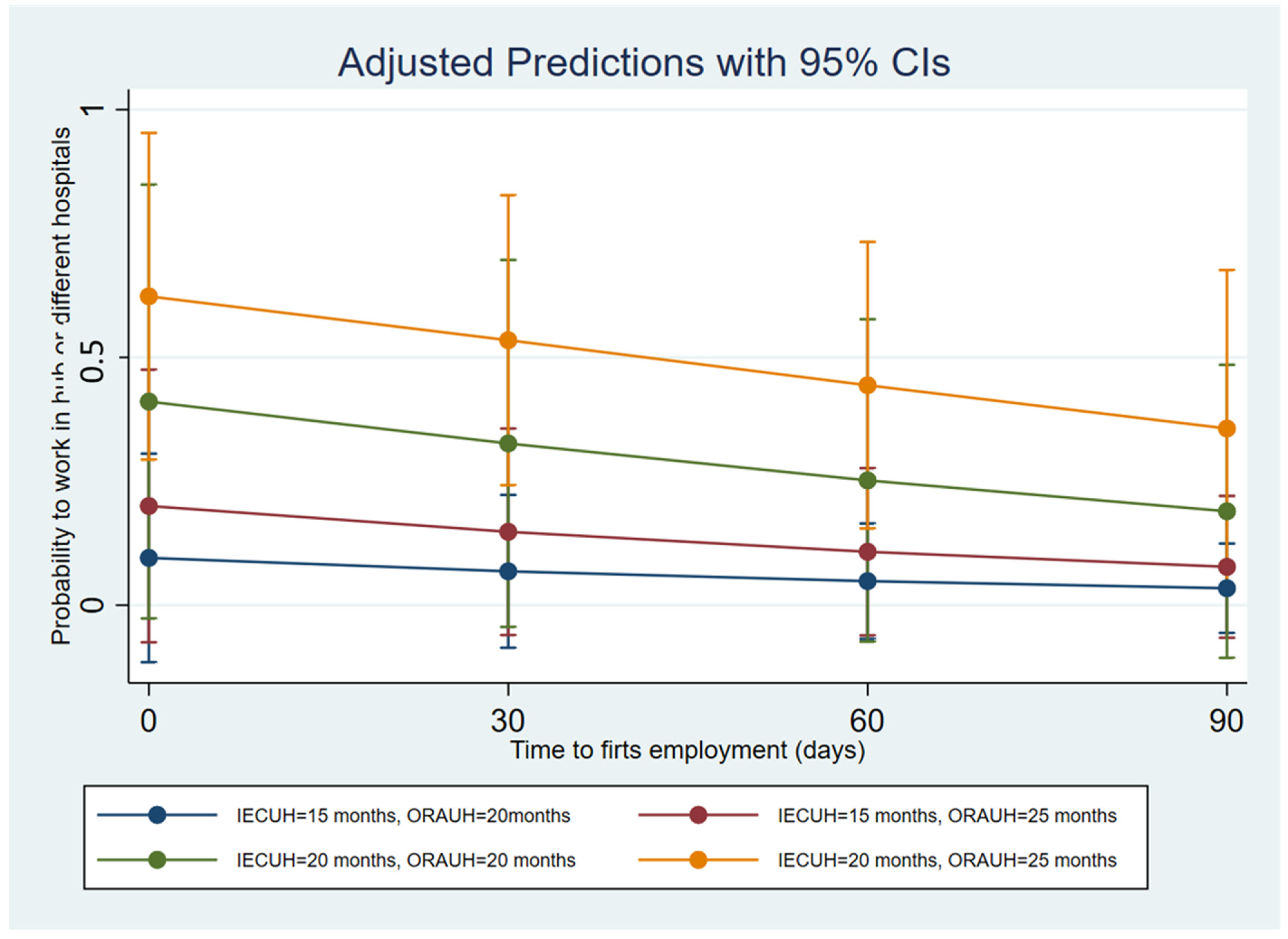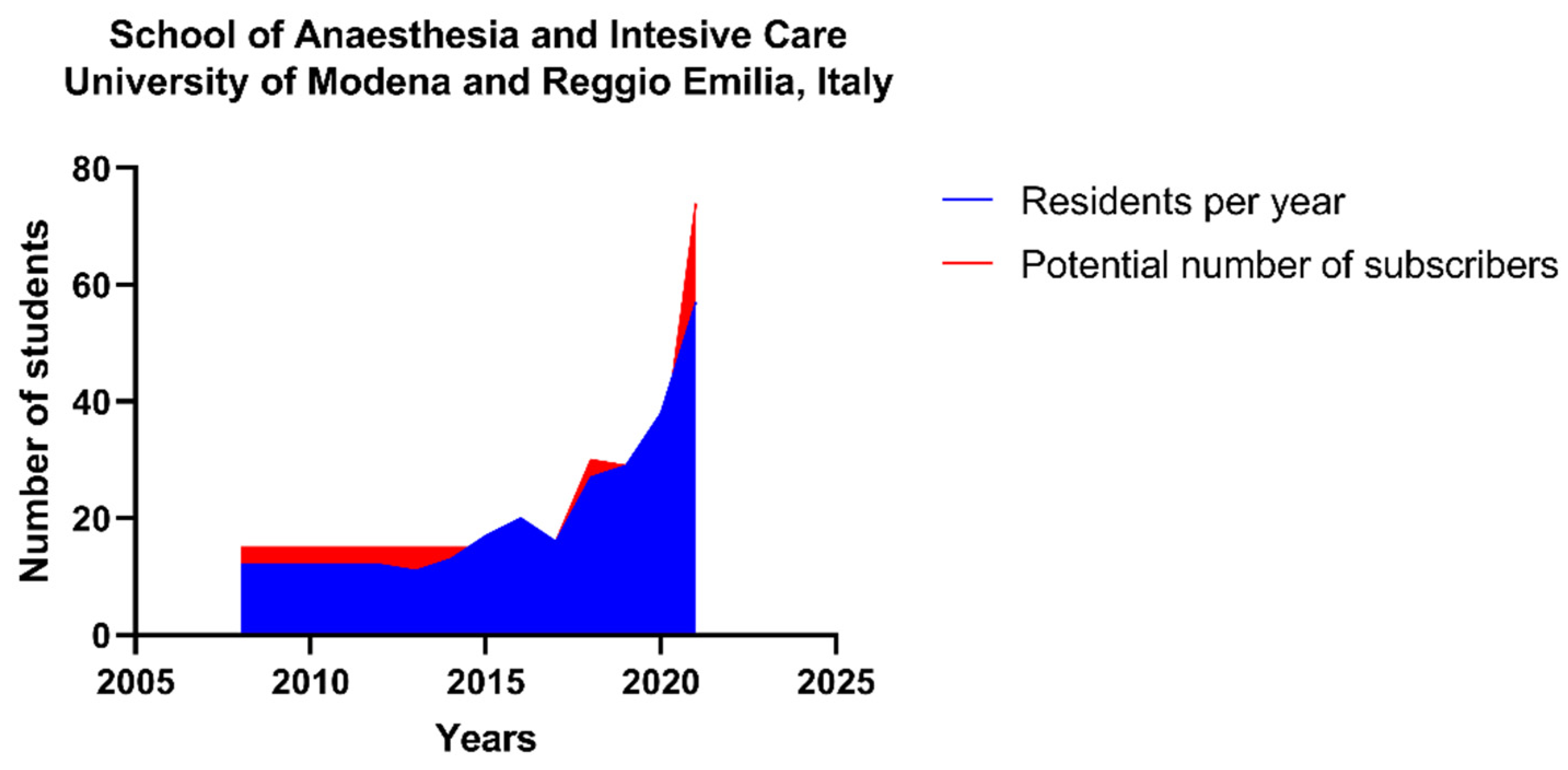Description, Organization, and Individual Postgraduate Perspectives of One Italian School of Anesthesia and Intensive Care
Abstract
:1. Introduction
Aims of the Study
2. Materials and Methods
3. Results
3.1. First Endpoint
3.2. Secondary Endpoint
4. Discussion
Strength and Limitations
5. Conclusions
Author Contributions
Funding
Institutional Review Board Statement
Informed Consent Statement
Data Availability Statement
Conflicts of Interest
Appendix A
| Health Facility | Site | Disciplines | Type of Hospital |
|---|---|---|---|
| Policlinico Teaching Hospital | Modena, Italy | Anesthesia and Intensive Care | Main domain of school: Poly-specialist hospital and pediatric and maternal hospital |
| Sant’Agostino Estense Public Hospital | Baggiovara (Modena), Italy | Anesthesia and Intensive Care | Main domain of school: Trauma Center and neuro critical care |
| Bernardo Ramazzini Public Hospital | Carpi (Modena), Italy | Anesthesia and Intensive Care | Peripheral Spoke |
| Santa Maria Nuova Public Hospital | Reggio Emilia, Italy | Anesthesia and Intensive Care | Principal hospital of Reggio Emilia, all disciplines excluded cardiac surgery |
| Public Hospital | Guastalla (Reggio Emilia), Italy | Anesthesia and Intensive Care | Peripheral Spoke |
| Health Facility | Site | Disciplines | Type of Hospital |
|---|---|---|---|
| Regina Margherita Public Hospital | Castelfranco Emilia (Modena), Italy | Chronic Pain Service | Chronic Pain Service |
| Villa Salus Private Hospital | Reggio Emilia, Italy | Anesthesia and Intensive Care | Cardiac surgery Center |
| Bellaria Public Hospital | Bologna, Italy | Anesthesia and Intensive Care | Neurocritical care Center |
| Montecatone Rheabilitation Center Private hospital | Imola (Bologna), Italy | Post critcal care Rehabilitation | Post critical care rehabilitation |
| 118 Service | Modena, Italy | Pre-hospital emergency care | Pre-hospital emergency care |
| School Program | Field | Mandatory or Optional | Year |
|---|---|---|---|
| General surgery | Anesthesia-Operating room | Mandatory | I-II and IV-V year |
| Orthopedic surgery | Anesthesia-Operating room | Mandatory | I-II and IV-V year |
| Obstetrician surgery | Anesthesia-Operating room | Mandatory | I-II and IV-V year |
| Urology surgery | Anesthesia-Operating room | Mandatory | I-II year |
| Otolaryngology surgery | Anesthesia-Operating room | Mandatory | I-II and IV-V year |
| Oral Maxillo-surgery | Anesthesia-Operating room | Mandatory | I-II year |
| Plastic Surgery | Anesthesia-Operating room | Mandatory | I-II year |
| Endoscopic Gastroenterology | Anesthesia-Operating room | Mandatory | II-IV year |
| Operative Radiology | Anesthesia-Operating room | Mandatory | II-IV year |
| Post-operative Intensive Care | Intensive Care and Resuscitation | Mandatory | II and IV-V year |
| School Program | Field | Mandatory or Optional | Year |
|---|---|---|---|
| Echo-cardio Lab | Transversal competence | Optional | III-IV year |
| Radiology Unit | Transversal competence | Optional | III-IV year |
| Nephrology Unit | Transversal competence | Optional | III-IV year |
| Pediatric Surgery | Anesthesia-Operating room | Mandatory | III-IV year |
| Vascular surgery | Anesthesia-Operating room | Mandatory | III-IV year |
| Neurosurgery | Anesthesia-Operating room | Mandatory | III-IV year |
| Cardiac Surgery | Anesthesia-Operating room | Optional | IV year |
| Transplant Surgery | Anesthesia-Operating room | Optional | IV year |
| Neurocritical care | Intensive Care and Resuscitation | Mandatory | IV year |
| Pre-hospital emergency | Intensive Care and Resuscitation | Mandatory | IV year |
| Chronic Pain Management | Pain Management | Mandatory | IV year |
| Hyperbaric Therapy | Hyperbaric Therapy | Mandatory | IV-V year |
| Abroad Experience | Transversal competence | Optional | IV-V year |
References
- Castanelli, D.J.; Weller, J.M.; Chander, A.R.; Molloy, E.K.; Bearman, M.L. A balancing act: The Supervisor of Training role in anaesthesia education. Anaesth. Intensive Care 2019, 47, 349–356. [Google Scholar] [CrossRef] [PubMed]
- Low, X.M.; Horrigan, D.; Brewster, D.J. The effects of team-training in intensive care medicine: A narrative review. J. Crit. Care 2018, 48, 283–289. [Google Scholar] [CrossRef] [PubMed]
- Plaud, B.; Bouzat, P.; Raux, M. Training and teaching in anaesthesia and critical care: Towards excellence. Anaesth. Crit. Care Pain Med. 2018, 37, 401–402. [Google Scholar] [CrossRef] [PubMed]
- MIUR. Available online: https://www.gazzettaufficiale.it/eli/id/2017/07/14/17A04639/sg (accessed on 18 February 2022).
- Aranaz Andrés, J.M.; Valencia-Martín, J.L.; Vicente-Guijarro, J.; Díaz-Agero Pérez, C.; López-Fresneña, N.; Carrillo, I.; Mira Solves, J.J.; Group, S.W. Low-Value Clinical Practices: Knowledge and Beliefs of Spanish Surgeons and Anesthetists. Int. J. Environ. Res. Public Health 2020, 17, 3556. [Google Scholar] [CrossRef]
- Turana, Y.; Primatanti, P.A.; Sukarya, W.S.; Wiyanto, M.; Duarsa, A.B.S.; Wratsangka, R.; Adriani, D.; Sasmita, P.K.; Budiyanti, E.; Anditiarina, D.; et al. Impact on Medical Education and the Medical Student’s Attitude, Practice, Mental Health, After One Year of the Covid-19 Pandemic in Indonesia. Front. Educ. 2022, 7, 8439998. [Google Scholar] [CrossRef]
- Barbieri, A.; Melegari, G.; Lob, V.; Mazzali, L.; D’Amelio, L.; Giovannoni, A.; Giuliani, E. Response by Twin Italian Hub Hospitals in a Double Seismic Event: A Retrospective Observational Investigation. Prehosp. Emerg. Care 2018, 22, 353–360. [Google Scholar] [CrossRef] [Green Version]
- Fajčíková, A.; Urbancová, H. Factors Influencing Students’ Motivation to Seek Higher Education—A Case Study at a State University in the Czech Republic. Sustainability 2019, 11, 4699. [Google Scholar] [CrossRef] [Green Version]
- Al-Abri, N.; Kooli, C. Factors Affecting the Career Path Choice of Graduates: A Case of Omani. Educ. Psychol. Cogn. Ejournal. 2018, 2, 105–117. [Google Scholar] [CrossRef]
- Melegari, G.; Giuliani, E.; Maini, G.; Barbieri, L.; Baffoni, P.; Bertellini, E.; Barbieri, A. Novel coronavirus (2019-nCov): Do you have enough intensive care units? Med. Intensiv. 2020, 44, 583–585. [Google Scholar] [CrossRef]
- Covid-19, in Gazzetta Ufficiale il Decreto per il Potenziamento del Ssn. Available online: https://www.salute.gov.it/portale/nuovocoronavirus/dettaglioNotizieNuovoCoronavirus.jsp?id=4188 (accessed on 24 June 2021).
- Giuliani, E.; Melegari, G.; Carrieri, F.; Barbieri, A. Overview of the main challenges in shared decision making in a multicultural and diverse society in the intensive and critical care setting. J. Eval. Clin. Pract. 2020, 26, 520–523. [Google Scholar] [CrossRef]
- Barbieri, A.; Giuliani, E.; Lazzerotti, S.; Villani, M.; Farinetti, A. Education in anesthesia: Three years of online logbook implementation in an Italian school. BMC Med. Educ. 2015, 15, 14. [Google Scholar] [CrossRef] [PubMed] [Green Version]
- Barbieri, A.; Melegari, G.; Giuliani, E. Could an electronic log-book be effective for medical training in anaesthesiology? Eur. J. Anaesthesiol. 2020, 37, 515. [Google Scholar] [CrossRef]
- Haight, E.S.; Chen, F.; Tanaka, P.; Brock-Utne, J.G.; Macario, A.; Sun, E.C.; Tawfik, V.L. Predictors of post-anaesthesiology residency research productivity: Preliminary report. Br. J. Anaesth. 2019, 123, e522–e524. [Google Scholar] [CrossRef] [PubMed]
- Kietaibl, S.; Blank, A.; De Robertis, E. Medical training in anaesthesiology: Updated European requirements. Eur. J. Anaesthesiol. 2019, 36, 473–476. [Google Scholar] [CrossRef] [PubMed] [Green Version]
- Kietaibl, S.; De Robertis, E. Reply to: Could an electronic log-book be effective for medical training in anaesthesiology? Eur. J. Anaesthesiol. 2020, 37, 516. [Google Scholar] [CrossRef]
- Soriero, D.; Atzori, G.; Barra, F.; Pertile, D.; Massobrio, A.; Conti, L.; Gusmini, D.; Epis, L.; Gallo, M.; Banchini, F.; et al. Development and Validation of a Homemade, Low-Cost Laparoscopic Simulator for Resident Surgeons (LABOT). Int. J. Environ. Res. Public Health 2020, 17, 323. [Google Scholar] [CrossRef] [Green Version]
- Erlenwein, J.; Meißner, W.; Petzke, F.; Pogatzki-Zahn, E.; Stamer, U.; Koppert, W. Staff and organizational requirements for pain services in hospitals: A recommendation from the German Society for Anaesthesiology and Intensive Care Medicine. Anaesthesist 2019, 68, 317–324. [Google Scholar] [CrossRef]
- Ruiz-Labarta, J.; Martínez Martín, A.; Pintado Recarte, P.; González Garzón, B.; Pina Moreno, J.M.; Sánchez Rodríguez, M.; Vallejo Gea, Á.; Sordo, L.; Álvarez-Mon, M.; Ortega, M.A.; et al. Workshop on Blood Loss Quantification in Obstetrics: Improving Medical Student Learning through Clinical Simulation. Healthcare 2022, 10, 399. [Google Scholar] [CrossRef]
- Orsolini, L.; Bellagamba, S.; Marchetti, V.; Menculini, G.; Tempia Valenta, S.; Salvi, V.; Volpe, U. A Preliminary Italian Cross-Sectional Study on the Level of Digital Psychiatry Training, Knowledge, Beliefs and Experiences among Medical Students, Psychiatry Trainees and Professionals. Healthcare 2022, 10, 390. [Google Scholar] [CrossRef]
- Hierlmeier, B.; Prem, A.; Anand, S.; Lerant, A.; Ostrovsky, G. Management of Malpositioned Double-Lumen Tubes: A Simulation-Based Training Exercise for Anesthesiology Residents. Int. Med. Educ. 2022, 1, 4–10. [Google Scholar] [CrossRef]
- Rivi, V.; Melegari, G.; Blom, J.M.C. How to humanise the COVID-19 intensive care units. BMJ Evid. Based Med. 2021, 26, 141–142. [Google Scholar] [CrossRef] [PubMed]
- Poluch, M.; Ries, R.; Ahmed, M. Effect of COVID-19 Pandemic on Medical Students—A Single Center Study. Int. Med. Educ. 2022, 1, 11–15. [Google Scholar] [CrossRef]




| Type of Hospital after 12 Months | I 2009–2014 | II 2010–2015 | III 2011–2016 | IV 2012–2017 | |
|---|---|---|---|---|---|
| Spoke hospital | 44.0% | 27.7% | 55.6% | 11% | |
| Hub Hospital | 22.2% | 63.7% | 33.3% | 66.67% | |
| Private Hospital | 33.0% | 9.09% | 11.1% | 22.2% | |
| 0.248 |
| I 2009–2014 | II 2010–2015 | III 2011–2016 | IV 2012–2017 | p Value | |
|---|---|---|---|---|---|
| Post graduated difficulties were present? (Yes) | 11% | 0% | 0% | 0% | 0.317 |
| Were all programs available to residents (No) | 25% | 18.8% | 0% | 0% | 0.177 |
| Percentage of Satisfaction (Yes) | 88.89% | 100% | 90.91% | 88.89% | 0.736 |
| Months/Observations (obs) | I 2009–2014 (9 obs) | II 2010–2015 (11 obs) | III 2011–2016 (11 obs) | IV 2012–2017 (9 obs) | p-Value |
|---|---|---|---|---|---|
| ORAUH (mean ± std. dev) | 29.4 ± 6.62 | 33.54 ± 5.78 | 27.81 ± 7.65 | 32.44 ± 5.70 | 0.188 |
| IECUH (mean ± std. dev) | 18.22 ± 2.68 | 15.45 ± 2.46 | 15.18 ± 5.87 | 18.44 ± 5.44 | 0.103 |
| School Network months (mean ± std. dev) | 7.55 ± 5.54 | 7.364 ± 4.22 | 9.18 ± 5.15 | 7.70 ± 3.86 | 0.769 |
| Abroad Experience months (mean ± std. dev) | 3.70 ± 3.84 | 2.54 ± 3.01 | 1.90 ± 2.34 | 1.33 ± 6.64 | 0.429 |
| Hub or Not | Odds. | St.Err. | t-Value | p-Value | [95% Conf | Interval] | Sig |
|---|---|---|---|---|---|---|---|
| IECUH | 1.459 | 0.226 | 2.44 | 0.015 | 1.077 | 1.977 | ** |
| ORAUH | 1.189 | 0.103 | 1.99 | 0.047 | 1.002 | 1.409 | ** |
| Time | 0.988 | 0.009 | −1.33 | 0.184 | 0.97 | 1.006 | |
| Constant | 0 | 0 | −2.37 | 0.018 | 0 | 0.139 | ** |
| Mean dependent var | 0.450 | SD Dependent var | 0.504 | ||||
| Pseudo r-squared | 0.216 | Number of obs | 40 | ||||
| Chi-square | 11.872 | Prob > chi2 | 0.008 | ||||
| Akaike crit. (AIC) | 51.179 | Bayesian crit. (BIC) | 57.934 | ||||
Publisher’s Note: MDPI stays neutral with regard to jurisdictional claims in published maps and institutional affiliations. |
© 2022 by the authors. Licensee MDPI, Basel, Switzerland. This article is an open access article distributed under the terms and conditions of the Creative Commons Attribution (CC BY) license (https://creativecommons.org/licenses/by/4.0/).
Share and Cite
Villani, M.; Lob, V.; Del Prete, A.; Guerra, E.; Chili, E.; Bertellini, E. Description, Organization, and Individual Postgraduate Perspectives of One Italian School of Anesthesia and Intensive Care. Int. J. Environ. Res. Public Health 2022, 19, 12645. https://doi.org/10.3390/ijerph191912645
Villani M, Lob V, Del Prete A, Guerra E, Chili E, Bertellini E. Description, Organization, and Individual Postgraduate Perspectives of One Italian School of Anesthesia and Intensive Care. International Journal of Environmental Research and Public Health. 2022; 19(19):12645. https://doi.org/10.3390/ijerph191912645
Chicago/Turabian StyleVillani, Matteo, Valentina Lob, Anna Del Prete, Emmanuele Guerra, Elisabetta Chili, and Elisabetta Bertellini. 2022. "Description, Organization, and Individual Postgraduate Perspectives of One Italian School of Anesthesia and Intensive Care" International Journal of Environmental Research and Public Health 19, no. 19: 12645. https://doi.org/10.3390/ijerph191912645







